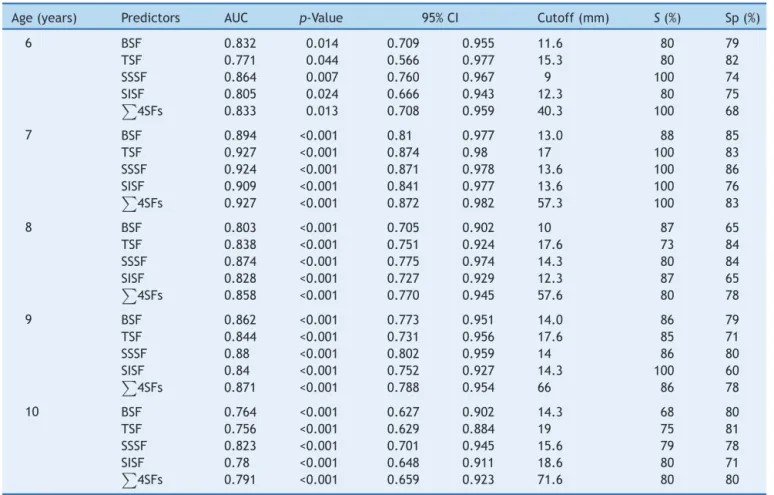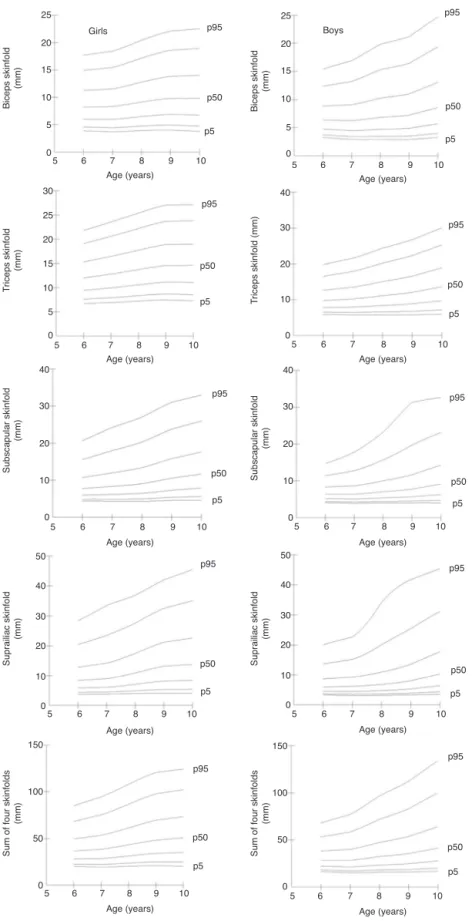www.jped.com.br
ORIGINAL
ARTICLE
Skinfold
reference
curves
and
their
use
in
predicting
metabolic
syndrome
risk
in
children
夽
,
夽夽
Alynne
C.R.
Andaki
a,∗,
Teresa
M.B.
de
Quadros
b,
Alex
P.
Gordia
b,
Jorge
Mota
c,
Adelson
L.A.
Tinôco
d,
Edmar
L.
Mendes
aaUniversidadeFederaldoTriânguloMineiro(UFTM),DepartamentodeCiênciasdoEsporte,Uberaba,MG,Brazil bUniversidadeFederaldoRecôncavodaBahia(UFRB),CentrodeFormac¸ãodeProfessores,CruzdasAlmas,BA,Brazil cUniversidadedoPorto,FaculdadedoDesporto,Porto,Portugal
dUniversidadeFederaldeVic¸osa(UFV),DepartamentodeNutric¸ãoeSaúde,Vic¸osa,MG,Brazil
Received28July2016;accepted16November2016 Availableonline23May2017
KEYWORDS
Anthropometry; Metabolicsyndrome X;
Cross-sectional studies; Child
Abstract
Objectives: Todrawskinfold(SF)referencecurves(subscapular,suprailiac,biceps,triceps)and todetermineSFcutoffpointsforpredictingtheriskofmetabolicsyndrome(MetS)inchildren aged6---10yearsold.
Methods: Thiswasacross-sectionalstudywitharandomsampleof1480childrenaged6---10 yearsold,52.2%females,frompublicandprivateschoolslocatedintheurbanandruralareas ofthemunicipalityofUberaba(MG).Anthropometry,bloodpressure,andfastingbloodsamples were taken atschool, following specific protocols. The LMSmethod was used todraw the referencecurvesandROCcurveanalysistodeterminetheaccuracyandcutoffpointsforthe evaluatedskinfolds.
Results: The four SFevaluated (subscapular, suprailiac, biceps, andtriceps) andtheir sum (4SF) wereaccurateinpredictingMetSfor bothgirlsandboys.Additionally, cutoffshave beenproposedandpercentilecurves(p5,p10,p25,p50,p75,p90,andp95)wereoutlinedfor thefourSFand4SF,forbothgenders.
Conclusion: SFmeasurementswereaccurateinpredictingmetabolicsyndromeinchildrenaged 6---10yearsold.Age-andgender-specificsmoothedpercentilescurvesofSFprovideareference forthedetectionofriskforMetSinchildren.
©2017PublishedbyElsevierEditoraLtda.onbehalfofSociedadeBrasileiradePediatria.Thisis anopenaccessarticleundertheCCBY-NC-NDlicense(http://creativecommons.org/licenses/ by-nc-nd/4.0/).
夽
Pleasecitethisarticleas:AndakiAC,QuadrosTM,GordiaAP,MotaJ,TinôcoAL,MendesEL.Skinfoldreferencecurvesandtheirusein predictingmetabolicsyndromeriskinchildren.JPediatr(RioJ).2017;93:490---6.
夽夽
StudycarriedoutatUniversidadeFederaldoTriânguloMineiro,Uberaba,MG,Brazil.
∗Correspondingauthor.
E-mail:alynneandaki@yahoo.com.br(A.C.Andaki).
http://dx.doi.org/10.1016/j.jped.2016.11.013
0021-7557/©2017PublishedbyElsevierEditoraLtda.onbehalfofSociedadeBrasileiradePediatria.Thisisanopenaccessarticleunder
PALAVRAS-CHAVE
Antropometria; SíndromeX; Estudosdecorte transversal; Crianc¸as
Curvasdereferênciadedobrascutâneasesuautilizac¸ãonapredic¸ãodorisco desíndromemetabólicaemcrianc¸as
Resumo
Objetivos: Desenharcurvasdereferênciadequatrodobrascutâneas(subescapular,suprailíaca, bíceps,tríceps)edeterminarpontosdecorteparapredizeroriscodeSMemcrianc¸asdeseis a10anosdeidade.
Métodos: Estudoepidemiológicodebasepopulacional,cortetransversal,comamostra prob-abilística,estratificadaporsegmentodeensino,com1.480crianc¸asde6a10anosdeidade, 52,2%dosexofeminino,oriundasdeescolaspúblicaseprivadas,localizadas nazonaurbana eruraldomunicípiodeUberaba(MG).Antropometria(dobrascutâneas),pressãoarterialeas coletasdesangueemjejumforamrealizadasemespac¸oreservadonaescola,seguindo proto-colosespecíficos.OmétodoloLMSfoiutilizadoparadesenharascurvasdereferênciaeanálise decurvaROCparadeterminaraacuráciaepontosdecorteparaasdobrascutâneasavaliadas. Resultados: As quatro DC avaliadas (subescapular, suprailíaca, bíceps e tríceps) e o seu somatório(4DC)foramacuradosnapredic¸ãodaSMparameninasemeninos.Adicionalmente, pontosdecorteforampropostosecurvaspercentílicas(p5,p10,p25,p50,p75,p90ep95)foram delineadasparaasquatroDCeo4DC,paraambosossexos.
Conclusão: Medidasde DC foram acuradas em predizerSM em escolares de seisa 10 anos
deidade.AscurvaspercentílicasdeDCdesenhadasporidadeesexofornecemreferênciana detecc¸ãodoriscodeSMemcrianc¸as.
©2017PublicadoporElsevierEditoraLtda.emnomedeSociedadeBrasileiradePediatria.Este ´
eumartigoOpenAccesssobumalicenc¸aCCBY-NC-ND(http://creativecommons.org/licenses/ by-nc-nd/4.0/).
Introduction
Cardiovascular diseases are the main cause of death in Brazil1 and worldwide.2 Cardiovascular risk factors, such astotalandvisceralobesity,dyslipidemias,arterial hyper-tension, hyperglycemia, and hyperinsulinemia have been considereddeterminantsforthedevelopmentof cardiovas-cular diseases. Metabolic syndrome (MetS), characterized by the presence of three or more of these risk factors,3 hasgainedimportanceduetoitsconsistentassociationwith cardiovascularmorbimortality.4
The presence of cardiovascular risk factors and MetS has been observed in adults5 as well as in children and adolescents.6In recent years,concerns aboutthe diagno-sisof andearly interventiononthesemetabolic disorders hasincreasedduetoevidencethatriskfactorsobservedin childhood and adolescencetend to persist and worsenin adulthood.7
In additiontobloodpressure(BP)andwaist circumfer-encemeasurements,biochemicalanalysesofbloodfractions of HDL-c, triglycerides, and glucoseshould be performed for the diagnosis of MetS.Bloodcollection is an invasive, expensiveanddifficulttoperformtechnique,especiallyin childrenandadolescents.Inturn,theuseofpracticaland low-costmethodsmaybeanimportantalternativefor the screening of MetS at the population level. In this sense, skinfolds(SFs)wereshown tobeapromisingtoolforMetS screeninginthepediatricpopulation,duetoitsstrong cor-relationwithsubcutaneousadiposity.8
According toAli et al.,9 the accumulation of subcuta-neous adiposity is a strong predictorof insulin resistance andhypertriglyceridemiainchildren andadolescents,and wasastrongerpredictorofcardiometabolicriskfactorsthan
visceral fat. Furthermore, the influence of subcutaneous adiposityonMetSriskispresentinchildrenandadolescents, butnotinadults.9
Percentile curves for SFs have been developed with samples of young North-American,10 Polish,11 and Indian populations.12 It is noteworthy that the World Health Organization13presentedanimportantpublicationin2007, in which reference curves for anthropometric measure-ments,includingtricepsandsubscapularSFswerecreated asaninternationalreferenceformulti-countrypopulations (Brazil,United States, Ghana, India, Norway, and Oman). However,to the best of the authors’ knowledge, SF per-centilecurveshavenotbeenproposedforBrazilianchildren, norarethereanySFpercentilecurvesthatcanbeusedto predictMetSinthepediatricpopulation.Referencecurves fromother populationsmaynotbeapplicabletoBrazilian childrenduetoethnic,cultural,andsocioeconomic differ-ences.
Therefore,thepresentstudyaimedtodesignreference curvesoffourSFs(subscapular, suprailiac,biceps,and tri-ceps)andtodeterminecutoffstopredicttheriskofMetSin childrenaged6---10years.
Methods
A cross-sectional, population-based epidemiological study wascarriedoutwithaprobabilisticsampleofchildrenaged 6---10yearsfrompublicandprivate schoolslocated inthe urbanandruralareasofthecityofUberaba,MG,Brazil.
confidencelevelof95%.Theminimumsamplesizewas768 children; after adding 10% to compensate for losses and refusalsand20%tominimizeconfoundingfactors,the sam-pletotaled1014children.
Forsampleselection,theschoolswerestratified accord-ingtothetypeofschoolasmunicipal,state,orprivate.
TheWorldHealthOrganization14recommendsthat10---15 samplecollectionpoints(schools)beusedfor epidemiolog-icalsurveys, andthatthenumberof subjectsineach age groupshouldvarybetween25and50foreachsite. There-fore,15 of the 90 eligibleschools of the municipality of Uberaba were randomly selected using the random num-bertable.Fortheadequacyandrepresentativenessofthe localpopulation, the number of children in each stratum was determined proportionally to the number of enroll-ments,according todataprovidedbytheStateEducation Secretariat.Municipalschoolsaccountedfor43.6%of enroll-ments,41.9%ofstudentswereenrolledfromstateschools and14.5%fromprivateschools.
After approval by the Ethics Committee in Research with Human Beings of Universidade Federal do Triângulo Mineiro (Protocol CEP/UFTM: 1710), the school principals were contacted to obtain authorization and to schedule thecollections.Studentswhomettheinclusioncriteriaand wereinterestedinparticipatingintheresearchreceivedthe informedconsentformfortheinformationandsignatureof theirparents and/or guardians. Anthropometryand blood collectionswere performed at theschool itself,following specificprotocols.
Thebiceps(BSF),triceps(TSF),subscapular(SSSF),and suprailiac (SISF) SFs were obtained using an adipometer (LangeSkinfoldCaliper,England,UK)exertingconstant pres-sure of 10g/mm2. Measurements were performed on the
rightside of thebody, withthreenon-consecutive repeti-tionsforeachmeasurement.Thefinalmeasureconstituted themeanofthethreevalues.Allmeasurementswere per-formed by twoqualified evaluatorssubmitted toprevious trainingandcalibration.Theresultswereinterpretedalone, aswellas bythe sumof the fourSFsassessed, andwere expressedinmillimeters(mm).
BP was measured using a mercury column sphygmo-manometer (Unitec, São Paulo, Brazil), with cuffs of appropriate sizes for the circumference of the children’s arms, in accordance with the VI Brazilian Guidelines for Hypertension.15ThreeBPmeasurementswereperformedat thefirstvisit,after whichthe firstwasdiscardedandthe meanofthelasttwowereconsidered.Whenthechildhad analterationinsystolicordiastolicBPabovethe90th per-centile,twofurthermeasurementswereperformedontwo differentdaysfollowingthesameprocedureadoptedonthe firstday.15
Thevolunteerswereinvitedtogotoschool,followinga 12-hfast,oncertaindaysandat certaintimes, accompa-niedbytheirparents.Nursingprofessionalscollectedblood samples(8mL)inBDVacutainerTMtubes(Becton,Dickinson
andCompany,NewJersey,USA).Serumsampleswere ana-lyzedforthemeasurementof HDL-candtriglyceridesand plasmaforglycemia.Thesemi-automatedBio200Fanalyzer (Bioplus,SãoPaulo, Brazil) wasused.Standardized meth-ods quantitatively determined blood variables, following thestandardsand technicalspecificationsof thereagents used.
ThediagnosisofMetS16wasdeterminedbythepresence ofat leastthreeofthefollowing alterations:triglycerides ≥100mg/dL;HDL-c<50mg/dL;glycemia≥110mg/dL;waist circumference ≥75th percentile for age and gender; and alteration in BP (diastolic or systolic) >90th percentile adjustedforage,heightandgender.
Variables were tested for their normality using the Kolmogorov---Smirnov test. Outliers were identified and withdrawn using the interval between quartiles. The Mann---Whitney U-test was used to compare independent groupswithnon-parametricdistribution.
Forcomparisonwithother studies,the5th,10th,25th, 50th,75th,90th,and95thpercentileswerechosenas refer-encevalues.ReferencecurveswerecreatedusingtheCole LMSmethod.17TheLMSmethodassumesthat,for indepen-dent data with positive values, the age-specific Box---Cox transformationcanbeemployedtomakethemhavea nor-mal distribution;theL,M,andS valuesarenatural cubic splines with knot sequence without each age range. The sample,ineachgender,wasseparatedintoagegroupswith 100 ormoreindividuals, thelowest numberconsideredto beadequatefortheLMSmethod.17
The receiver operating characteristic (ROC) curve was usedtoevaluatethepredictivecapacityofdiagnostictests. The areasbelowtheROCcurves(AUC)werecalculatedto assessthediscriminatorypoweroftheSFsintheindication ofmetabolicalterationsconstitutingtheMetS.The sensitiv-ityandspecificity valuesoftheanthropometricindicators werecalculatedforeachcutoffpresentinthesample.The cutoffthatshowedthebestequilibriumbetween sensitiv-ityand specificity waschosen tooptimizetheassociation between these two parameters, showing higher accuracy (lowernumberoffalsenegativeandfalsepositivevalues). Thestatisticalsignificanceofeachanalysiswasverifiedby theAUCandbythelowerlimitofthe95%confidenceinterval >0.5.18
Results
Atotalof1480elementaryschoolstudentsfromtheurban andruralareasofUberaba,MG,Brazil,withameanageof 8.55years(SD=1.53years),ofwhom52.2%werefemales, participatedinthestudy.
Girlshada higherprevalence of MetS(12.6% vs. 8.5%,
p<0.05) and higher SF values in all assessed anatomical points(p<0.05)whencomparedwithboys(Table1).
Percentilecurves(p5,p10,p25,p50,p75,p90,andp95) werecreatedforthefourassessedSFs,aswellasfortheir sum,forbothgenders(Fig.1).Overall,allSFsshoweda lin-earincreaseaccordingtoageandgender,withhighervalues beingobservedingirls.
The four assessed SFs and their sum were accurate in predictingMetSforgirls(Table2)andboys(Table3).Most of thesuggested valuesareabovethe75thpercentilefor ageandgender.
Discussion
Table1 Descriptiveskinfoldcharacteristicsofschoolchildrenaged6---10yearsofage,fromthemunicipalityofUberaba,MG, Brazil,bygender.
Variables Girls(n=773) Boys(n=707) p-Value
Mean(SD) Median(min---max) Mean(SD) Median(min---max)
BSF(mm) 10.14(5.15) 9.00(3.00---29.00) 8.57(5.29) 6.67(3.00---28.00) 0.001 TSF(mm) 14.45(5.66) 13.33(5.00---35.00) 12.71(6.67) 10.67(5.00---35.00) 0.001 SSSF(mm) 11.77(7.63) 9.00(4.00---44.00) 9.85(7.50) 7.00(4.00---44.00) 0.001 SISF(mm) 14.40(10.56) 9.67(3.00---51.00) 11.12(10.23) 6.67(3.00---50.00) 0.001
4SFs(mm) 50.93(28.31) 42.0(10.00---163.00) 42.37(29.79) 31.00(11.00---202.67) 0.001
n,samplenumber;SD,standarddeviation;Min,minimumvalue;Max,maximumvalue;TSF,tricepsskinfold;BSF,bicepsskinfold;SSSF, subscapularskinfold;SISF,suprailiacskinfold;4SFs,sumofthefourskinfoldsevaluated.
Note:Significantdifferencebetweengendersp≤0.05,Mann---Whitneytest.
Table2 Skinfoldcutoffsforpredictingmetabolicsyndromeingirls,byage,municipalityofUberaba,MG,Brazil.
Age(years) Predictors AUC p-Value 95%CI Cutoff(mm) S(%) Sp(%)
6 BSF 0.832 0.014 0.709 0.955 11.6 80 79
TSF 0.771 0.044 0.566 0.977 15.3 80 82
SSSF 0.864 0.007 0.760 0.967 9 100 74
SISF 0.805 0.024 0.666 0.943 12.3 80 75
4SFs 0.833 0.013 0.708 0.959 40.3 100 68
7 BSF 0.894 <0.001 0.81 0.977 13.0 88 85
TSF 0.927 <0.001 0.874 0.98 17 100 83
SSSF 0.924 <0.001 0.871 0.978 13.6 100 86
SISF 0.909 <0.001 0.841 0.977 13.6 100 76
4SFs 0.927 <0.001 0.872 0.982 57.3 100 83
8 BSF 0.803 <0.001 0.705 0.902 10 87 65
TSF 0.838 <0.001 0.751 0.924 17.6 73 84
SSSF 0.874 <0.001 0.775 0.974 14.3 80 84
SISF 0.828 <0.001 0.727 0.929 12.3 87 65
4SFs 0.858 <0.001 0.770 0.945 57.6 80 78
9 BSF 0.862 <0.001 0.773 0.951 14.0 86 79
TSF 0.844 <0.001 0.731 0.956 17.6 85 71
SSSF 0.88 <0.001 0.802 0.959 14 86 80
SISF 0.84 <0.001 0.752 0.927 14.3 100 60
4SFs 0.871 <0.001 0.788 0.954 66 86 78
10 BSF 0.764 <0.001 0.627 0.902 14.3 68 80
TSF 0.756 <0.001 0.629 0.884 19 75 81
SSSF 0.823 <0.001 0.701 0.945 15.6 79 78
SISF 0.78 <0.001 0.648 0.911 18.6 80 71
4SFs 0.791 <0.001 0.659 0.923 71.6 80 80
AUC,areaunderthereceiveroperatingcharacteristiccurve;95%CI,95%confidenceinterval;S,sensitivity;Sp,specificity;TSF,triceps skinfold;BSF,bicepsskinfold;SSSF,subscapularskinfold;SISF,suprailiacskinfold;4SFs,sumofthefourassessedskinfolds.
to age and gender in Brazilian children. The curves out-lined here may be a useful strategy to prevent the risk ofMetSin childhood,withthepossibilityof beingusedin schools,familyhealthunits,clinics,andhospitals. Accord-ing tothe present findings,both the central adiposity,as well as the peripheral adiposity SFs and the sum of four SFsshowedcutoffswithhighsensitivityandspecificity val-uestopredict therisk ofMetSin children.Approximately 75% of the children in the present study with SF values abovethe75thpercentile,regardlessoftheassessedSF,had MetS.
Girls Boys
Age (years)
Age (years)
Age (years)
Age (years)
Age (years)
Age (years)
Age (years)
Age (years) Age (years) Age (years)
Biceps skinfold
(mm)
T
riceps skinfold
(mm)
Subscapular skinfold
(mm)
Suprailiac skinfold
(mm)
Sum of four skinfolds
(mm)
Sum of four skinfolds
(mm)
Suprailiac skinfold
(mm)
Subscapular skinfold
(mm)
T
riceps skinfold (mm)
25
20
15
10
5
0
25
30 40
30
20
10
0
40
30
20
10
0
40 50
30
20
10
150
100
50
0
150
100
50
0 0
40 50
30
20
10
0 40
30
20
10
0 20
15
10
5
0
Biceps skinfold
(mm)
25
20
15
10
5
0 5 6 7 8 9 10
5 6 7 8 9 10
5 6 7 8 9 10
5 6 7 8 9 10
5 6 7 8 9 10 5 6 7 8 9 10
5 6 7 8 9 10 5 6 7 8 9 10 5 6 7 8 9 10 5 6 7 8 9 10 p5
p5
p5
p5
p5
p5 p5 p5 p5 p5 p50
p50
p95
p95
p95
p95 p95 p95
p50
p50
p50
p50 p50 p50 p50 p50 p95
p95
p95 p95
Figure1 Percentilecurves(p5,p10,p25,p50,p75,p90,andp95)ofthetriceps,biceps,subscapular,andsuprailiacskinfolds,as wellasfortheirsum,ofgirlsandboysaged6---10years,Uberaba,MG,Brazil.
Thepercentiledistributionofthetricepsand subscapu-larSFswereperformedin8568Chineseschoolchildrenaged 7---18yearsofage21and32,783North-Americanchildrenand
Table3 Skinfoldcutoffsforpredictingmetabolicsyndromeingirls,byage,municipalityofUberaba,MG,Brazil.
Age(years) Predictors AUC p-Value 95%CI Cutoff(mm) S(%) Sp(%)
6 BSF 0.95 0.002 0.902 1.00 13.3 100 91.5
TSF 0.95 0.002 0.893 1.00 16.0 100 88.7
SSSF 0.93 0.004 0.854 1.00 8.6 100 82.6
SISF 0.90 0.007 0.807 0.997 11.3 100 81.6
4SFs 0.94 0.003 0.87 1.00 51.3 100 86.1
7 BSF 0.86 0.007 0.726 0.994 8.3 80 72.2
TSF 0.83 0.015 0.681 0.969 11.6 80 72.6
SSSF 0.90 0.003 0.789 1.00 7.6 100 71.6
SISF 0.82 0.016 0.635 1.00 7.0 60 60.7
4SFs 0.86 0.007 0.71 1.00 32.3 100 66.2
8 BSF 0.84 0.044 0.641 1.00 8.3 66.6 63.1
TSF 0.84 0.048 0.626 1.00 11.6 66.6 61.1
SSSF 0.88 0.025 0.756 1.00 9.3 100 73.9
SISF 0.91 0.016 0.821 1.00 13.3 100 82.5
4SFs 0.89 0.024 0.761 1.00 42.6 100 75.5
9 BSF 0.86 0.001 0.767 0.955 10 87.5 68.2
TSF 0.86 0.001 0.769 0.954 14.6 88.8 72.0
SSSF 0.92 0.001 0.868 0.980 12.3 100 83.7
SISF 0.92 0.001 0.852 0.982 14.6 88.8 81.4
4SFs 0.90 0.001 0.832 0.974 55.3 88.8 81.4
10 BSF 0.80 0.001 0.678 0.930 11.3 86.6 70.9
TSF 0.78 0.001 0.645 0.917 17.3 80 79.6
SSSF 0.77 0.002 0.638 0.905 13.3 80 72.3
SISF 0.79 0.001 0.653 0.920 22.0 73.3 86.3
4SFs 0.79 0.001 0.661 0.920 61.6 80.0 80.3
AUC,areaunderthereceiveroperatingcharacteristiccurve;95%CI,95%confidenceinterval;S,sensitivity;Sp,specificity;TSF,triceps skinfold;BSF,bicepsskinfold;SSSF,subscapularskinfold;SISF,suprailiacskinfold;4SFs,sumofthefourassessedskinfolds.
ofconcern,duetotheassociationbetweenSFsandcentral obesity,unfavorablelipidprofile,increasedlevelsofinsulin andBP,andleftventricularmass.22Theaccumulationof sub-cutaneousfat,translatedintohighSFvalues,increasethe chancesofchildrenhavingmetabolicalterations.
Pre-pubertal Mexican children aged 6---10 years had a three-foldhigherchanceofhavingalterationsinMetS com-ponents when the distribution of SSSF was in the fourth quartileofthesample(lowHDL-clevels[OR=3.16;95%CI: 1.41---7.10;p<0.01])andhightriglyceridelevels(OR=3.27; 95%CI:2.02---5.29;p<0.001).23However,highvaluesof
3SF (TSF+BSF+SSSF;>90thpercentile)inGermanchildrenaged 3---11yearsincreasedthechanceofhavingthreeormore car-diovascularriskfactorsby1.6-fold(95%CI:1.1---2.2;p<0.05) andthechance ofhavingarterialhypertensionby1.7-fold (95%CI:1.1---2.7;p<0.05)].24
The results of thepresent study demonstratedthat all isolatedSFmeasures predicttherisk ofMetSinboth gen-ders.Inthescientificinvestigationsrelatedtothesubject, studies withTSF and SSSF arepredominant.10,13,21,25 Many studies have used SF values alone as a predictor of the amount of body fat25---29 and isolated cardiometabolicrisk factors.12,30Conversely,studiesinvestigatingthepowerofSF inpredictingMetSinthepediatricpopulationremainscarce. The use of thesumof SFabsolute valuesmaybecome an interesting predictor of MetS, as it minimizes biases in predictive body composition equations, as well as
suggesting valuesthat show equilibrium/disequilibrium of bodyfatdistribution(TSF+BSF+SSSF+SISF).Amongthe dif-ferentanthropometricmeasurestested,4SFwasthemost accuratepredictorofMetSinBraziliangirlsandboys,with AUC=0.908andAUC=0.897,respectively.6
Inthepresentstudy,the4SFshowedanAUCof0.859 for girls and 0.879 for boys, and the suggested cutoffs showedhighsensitivityvalues(>80%).
To thebestof the authors’knowledge, thisis thefirst studywithpercentilecurvesofthecentralandperipheral regionSFs,aswellasthesumoffourSFs,usedtopredict MetSinarepresentativesampleofBrazilianschools. How-ever,thisstudyhadacross-sectionaldesign,whichdidnot allow the determination of whether alterations in subcu-taneousadiposityreflectchangesintheMetScomponents. Thus,longitudinalstudiesarenecessarytodefinethecausal associationbetweenMetSandsubcutaneousadiposity.Itis worthmentioningthat,althoughthestudypopulation was delimitedamongstudentsfromthe1sttothe5thyearof Ele-mentarySchool, the StateEducation Secretariatprovided updateddata on all ElementarySchool years, which may haveoverestimatedthesamplecalculation.
screening of MetSin young individuals throughthe evalu-ationofSFs.
Funding
Fundac¸ãodeAmparoàPesquisadoEstadodeMinasGerais (Fapemig).
Conflicts
of
interest
Theauthorsdeclarenoconflictsofinterest.
References
1.MansurAP,FavaratoD.Mortalityduetocardiovasculardiseases inBrazilandinthemetropolitanregionofSaoPaulo:a2011 update.ArqBrasCardiol.2012;99:755---61.
2.WorldHealthOrganization.Theglobalburdenofdisease:2004 update.Geneva:WHO;2008.
3.Expert panel on detection evaluation, treatment of high blood cholesterolin adults. Executivesummary of thethird reportofthenationalcholesteroleducation program(NCEP) expertpanelondetection,evaluation,andtreatmentofhigh bloodcholesterolinadults(AdultTreatmentPanelIII).JAMA. 2001;285:2486---97.
4.Isomaa B, Almgren P,Tuomi T, Forsen B, Lahti K, NissenM, etal.Cardiovascularmorbidityandmortalityassociatedwith themetabolicsyndrome.DiabetesCare.2001;24:683---9.
5.SrinivasanSR,MyersL,BerensonGS.Predictabilityofchildhood adiposityandinsulinfordevelopinginsulinresistancesyndrome (syndromeX) inyoung adulthood: theBogalusaHeart Study. Diabetes.2002;51:204---9.
6.Andaki AC,TinocoAL, MendesEL,Andaki JuniorR, HillsAP, Amorim PR.Anthropometryand physicalactivitylevelinthe prediction ofmetabolic syndrome inchildren. Public Health Nutr.2014;17:2287---94.
7.KatzmarzykPT,PerusseL,MalinaRM,BergeronJ,DespresJP, BouchardC.Stabilityofindicatorsofthemetabolicsyndrome fromchildhoodandadolescencetoyoungadulthood:the Que-becFamilyStudy.JClinEpidemiol.2001;54:190---5.
8.MisraA,VikramNK,AryaS,PandeyRM,DhingraV,Chatterjee A,etal.Highprevalenceofinsulinresistanceinpostpubertal AsianIndianchildrenisassociatedwithadversetruncalbodyfat patterning,abdominaladiposityandexcessbodyfat.IntJObes RelatMetabDisord.2004;28:1217---26.
9.Ali O, Cerjak D,Kent JW Jr,James R, Blangero J,Zhang Y. Obesity,centraladiposity andcardiometabolicriskfactorsin childrenandadolescents:afamily-basedstudy.PediatrObes. 2014;9:e58---62.
10.AddoOY,HimesJH.Referencecurvesfortricepsand subscapu-larskinfoldthicknessesinUS childrenand adolescents.AmJ ClinNutr.2010;91:635---42.
11.Jaworski M,KulagaZ, PludowskiP,Grajda A,Gurzkowska B, Napieralska E,etal. Population-basedcentile curvesfor tri-ceps,subscapular,andabdominalskinfoldthicknessesinPolish children and adolescents --- the OLAF study. Eur J Pediatr. 2012;171:1215---21.
12.Khadilkar A, MandlikR, Chiplonkar S,Khadilkar V,Ekbote V, Patwardhan V. Reference centile curves for triceps skinfold thickness forIndianchildrenaged5to 17yearsand cutoffs
forpredicting riskofchildhoodhypertension:a multi-centric study.IndianPediatr.2015;52:675---80.
13.World Health Organization. WHO child growth standards: head circumference-for-age,arm circumference-for-age, tri-cepsskinfold-for-ageandsubscapularskinfold-for-age.Methods anddevelopment.Geneva:WHO;2007.
14.WorldHealthOrganization.Oralhealthsurveys:basicmethods. Geneva:WorldHealthOrganization;1997.
15.Sociedade Brasileira de Cardiologia, Sociedade Brasileira de Hipertensão,SociedadeBrasileira deNefrologia.VI diretrizes brasileiras de hipertensão. Arq Bras Cardiol. 2010;95 Suppl. 1:1---51.
16.deFerrantiSD,GauvreauK,LudwigDS,NeufeldEJ,Newburger JW,RifaiN.Prevalenceofthemetabolicsyndromein Ameri-canadolescents:findingsfrom theThirdNationalHealthand NutritionExaminationSurvey.Circulation.2004;110:2494---7.
17.ColeTJ,GreenPJ.Smoothingreferencecentilecurves:theLMS methodandpenalizedlikelihood.StatMed.1992;11:1305---19.
18.SchistermanEF,FaraggiD,ReiserB,TrevisanM.Statistical infer-encefortheareaunderthereceiveroperatingcharacteristic curveinthepresenceofrandommeasurementerror.AmJ Epi-demiol.2001;154:174---9.
19.TavaresL, YokooE, RosaM, Fonseca S. Metabolicsyndrome inBrazilianchildrenandadolescents:systematicreview.Cad SaudeColet.2010;18:469---76.
20.FriendA,CraigL,TurnerS.Theprevalenceofmetabolic syn-dromeinchildren:asystematicreviewoftheliterature.Metab SyndrRelatDisord.2013;11:71---80.
21.Ying-XiuZ,Shu-RongW.Distributionofskinfoldthicknessand bloodpressureamongchildrenand adolescentsinShandong, China.JTropPediatr.2011;57:258---62.
22.FreedmanDS,SerdulaMK,SrinivasanSR,BerensonGS.Relation ofcircumferencesandskinfoldthicknessestolipidandinsulin concentrationsinchildrenandadolescents:theBogalusaHeart Study.AmJClinNutr.1999;69:308---17.
23.Ramirez-VelezR,Suarez-OrtegonMF,AguilardePlataAC. Asso-ciation between adiposity and cardiovascular risk factors in prepubertalchildren.EndocrinolNutr.2011;58:457---63.
24.HaasGM,LiepoldE,SchwandtP.Predictingcardiovascularrisk factorsbydifferentbodyfatpatternsin3850Germanchildren: thePEPfamilyheartstudy.IntJPrevMed.2011;2:15---9.
25.KriemlerS,Puder J,ZahnerL, RothR, MeyerU, BedogniG. Estimationofpercentagebodyfatin6-to13-year-oldchildren byskinfoldthickness,bodymassindexandwaistcircumference. BrJNutr.2010;104:1565---72.
26.FreedmanDS,WangJ,OgdenCL,ThorntonJC,MeiZ,Pierson RN,etal.ThepredictionofbodyfatnessbyBMIandskinfold thicknessesamong childrenand adolescents. Ann Hum Biol. 2007;34:183---94.
27.AyatollahiSM, Mostajabi F.Tricepsskinfold thickness centile chartsinprimaryschoolchildreninShiraz,Iran.ArchIranMed. 2008;11:210---3.
28.BedogniG,IughettiL,FerrariM,MalavoltiM,PoliM,Bernasconi S,etal.Sensitivityandspecificityofbodymassindexand skin-foldthicknessesindetectingexcessadiposityinchildrenaged 8---12years.AnnHumBiol.2003;30:132---9.
29.Pecoraro P, Guida B, Caroli M, Trio R, Falconi C, Princi-patoS,et al.Bodymassindex and skinfoldthicknessversus bioimpedanceanalysis:fat mass predictioninchildren. Acta Diabetol.2003;40:S278---81.


